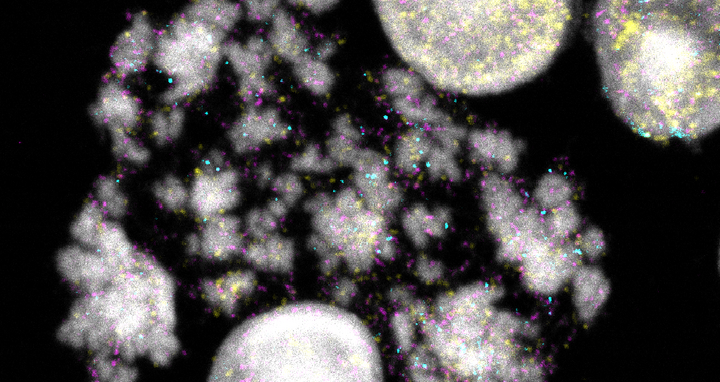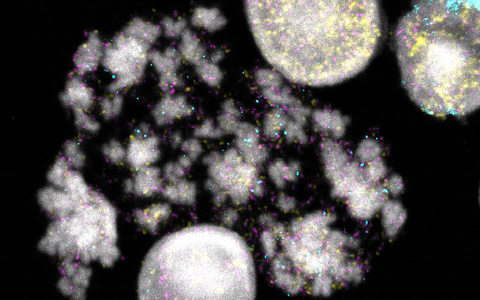How cancer genes become independent
Joint press release of Charité - Universitätsmedizin Berlin and the Max Delbrück Center
To tell the difference between dangerous and harmless DNA rings and be able to trace their evolution within the tumor, we have to look at the tissue one cell at a time.
Considered one of the biggest challenges in cancer research, DNA rings are tiny loops of genetic material floating around the nucleus of the cell by the hundreds, detached from the chromosomes. Nearly one-third of all tumors in pediatric and adult patients have DNA rings inside their cells – and those tumors are almost always highly aggressive. Ring-shaped DNA, termed extrachromosomal DNA (ecDNA), is also often implicated when a tumor develops resistance to a previously effective medication. Researchers around the world hope to identify new approaches to treating cancer by studying this specific form of genetic information. However, ecDNA does not always have a detrimental effect on cancer growth.
“To tell the difference between dangerous and harmless DNA rings and be able to trace their evolution within the tumor, we have to look at the tissue one cell at a time,” explains the head of the study, Professor Anton Henssen. He works at the Department of Pediatric Oncology and Hematology at Charité and does research at the Experimental and Clinical Research Center (ECRC), a joint institution of Charité and the Max Delbrück Center. Together with his team, he has now developed a technology that can read the genetic code of the existing DNA rings for each individual cell. At the same time, it tells which genes are active on the rings. “This lets us simply count how many cells in the tumor are home to a specific ring,” Henssen says. “If there aren’t many, then that ring is not highly relevant to the growth of the cancer. But if there are a lot of them, it evidently gives a tumor cell a selective advantage.”
Which DNA rings spur tumor growth?
The researchers initially used the new method to take a snapshot of all DNA rings in cultured neuroblastoma cells. Neuroblastoma is a form of highly malignant cancer that is especially prevalent in very young children. The research showed that no two cancer cells are alike – where one might have 100 DNA rings floating around, the next might have 2,000. The rings also vary greatly in size, with the smallest of them consisting of only 30 genetic components and the largest comprising over a million.
Nuclei and chromosomes of neuroblastoma cells. DNA rings are colored yellow, turquoise, or magenta. Each color is associated with different cancer genes.
“The big DNA rings are loaded with cancer genes originating in the chromosomes of the cell,” explains Rocío Chamorro González, the study’s first author, who works in Henssen’s lab. “The ring shape lets them circumvent the classic laws of genetics, so they take on a kind of autonomy. These cancer genes have struck out on their own, if you will. We are only just starting to understand the ramifications. In our study, we found the large DNA rings in many neuroblastoma cells, so they are evidently spurring cell growth. The small rings were only found in isolation, so they are probably not very relevant to the cancer cells.”
Evolution of an independent cancer gene
To understand how an ecDNA originates in the first place and then evolves within a tumor, the second step for the research group was to analyze a pediatric neuroblastoma – cell by cell. Their findings suggest that MYCN, a known cancer gene, first detached from its chromosome of origin and formed a ring shape at the start of the tumor’s growth in this case. Then two of the rings merged to form a larger one, which went on to lose a shorter segment and then a longer one. “The last ring seems to have been the first to confer a growth advantage, because it is the only one that appears in many of the neuroblastoma cells,” Henssen says. “This shows that the cancer gene not only became independent through these processes, but also continued to ‘improve.’”
This kind of insight into the evolution of DNA rings within a tumor would have been impossible if not for the newly developed method. The team of researchers now plans to use the same method to reconstruct the stages of development in further cases of cancer.
Further information
- Stopping repair mechanisms in tumors
- Solving the mystery of DNA rings
- The Department of Pediatric Oncology and Hematology at the Charité
- Press release by Charité
Literature
Chamrro González R et al. (2023): “Parallel sequencing of extrachromosomal circular DNAs and transcriptomes in single cancer cells.” Nature Genetics, DOI: 10.1038/s41588-023-01386-y
Downloads
Nuclei and chromosomes of neuroblastoma cells. DNA rings are colored yellow, turquoise, or magenta. Each color is associated with different cancer genes. © Charité | Rocío Chamorro González
Contacts
Professor Anton Henssen
Department of Pediatric Oncology and Hematology
Experimental and Clinical Research Center (ECRC)
Charité – Universitätsmedizin Berlin
+49 30 450 566 132
anton.henssen@charite.de
Christina Anders
Editor, Communications Department
Max Delbrück Center
+49-(0)30-9406-2118
christina.anders@mdc-berlin.de or presse@mdc-berlin.de
- Max Delbrück Center
-
The Max Delbrück Center for Molecular Medicine in the Helmholtz Association (Max Delbrück Center) is one of the world’s leading biomedical research institutions. Max Delbrück, a Berlin native, was a Nobel laureate and one of the founders of molecular biology. At the locations in Berlin-Buch and Mitte, researchers from some 70 countries study human biology – investigating the foundations of life from its most elementary building blocks to systems-wide mechanisms. By understanding what regulates or disrupts the dynamic equilibrium of a cell, an organ, or the entire body, we can prevent diseases, diagnose them earlier, and stop their progression with tailored therapies. Patients should be able to benefit as soon as possible from basic research discoveries. This is why the Max Delbrück Center supports spin-off creation and participates in collaborative networks. It works in close partnership with Charité – Universitätsmedizin Berlin in the jointly-run Experimental and Clinical Research Center (ECRC), the Berlin Institute of Health (BIH) at Charité, and the German Center for Cardiovascular Research (DZHK). Founded in 1992, the Max Delbrück Center today employs 1,800 people and is 90 percent funded by the German federal government and 10 percent by the State of Berlin.







